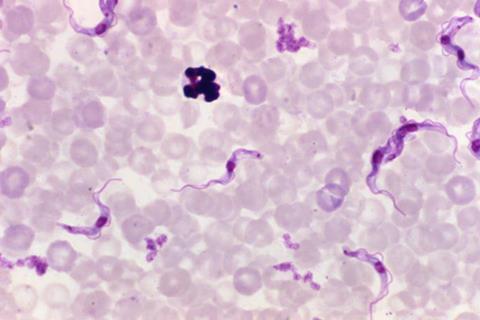A parasite which has devasting impacts on agriculture and human health is the first pathogen to have its proteins located and mapped within its cells – providing clues to their function and helping to identify potential drug targets.

African trypanosomes are parasites transmitted by tsetse flies that cause sleeping sickness in humans (presenting as fever, anaemia and, in serious cases, death) and a similar disease celled nagana in cattle. These parasites have made large areas of Africa unsuitable for livestock production, costing rural farmers up to £3.7 billion each year in lost revenue.
For the first time ever, scientists have developed a detailed “protein atlas” of a pathogen – a kind of biological map that locates proteins in cells. They conducted the research on Trypanosoma brucei (T. brucei), helping to understand where proteins are within its cells, providing functional insights that may ultimately help treat parasite infections.
Divergent evolution
The benefits of this ground-breaking research by the Universities of Warwick, Oxford and Oxford Brookes do not stop there. In mapping the proteins within T. brucei, scientists now understand more about its evolutionary cell biology. Like humans, T. brucei are eukaryotes – meaning their cells have a nucleus. However, T. brucei evolved in a very divergent way to human cells. Exploring protein mapping sheds light on how it evolved to be so different.
Samuel Dean, Assistant Professor of parasitology at the University of Warwick, said: “In this study, we genetically modified trypanosome parasites to make proteins attached to a green fluorescent dye. This helped to show exactly where its proteins are within the cell. Using this information, we are able to understand more about what these proteins might be doing. Up until now 50% of the proteins in T. brucei had unknown functions.
“This has significant impacts on our understanding of pathogen evolution and provides functional clues for thousands of otherwise uncharacterised proteins. This will help further investigations and may help to inform on new treatments for these terrible diseases.”
Evolution of nucleated cells
Professor Keith Matthews, expert in parasite biology at the University of Edinburgh, added: “This important resource will be of immense long-term value to researchers focused on these devastating pathogens, but also helps to understand the protein function and evolution of all nucleated cells, including our own.”
University of Ghana senior lecturer, Theresa Manful Gwira, who is Head of Research Training at the West African Centre for Cell Biology of Infectious Pathogens, added: “This is a very important work, and a powerful resource that will be useful to many researchers including African scientists that work on the devastating African trypanosomiasis, thus contributing to a better understanding of the parasite biology.”
This research was funded by The Wellcome Trust.
Topics
- Infectious Disease
- Keith Matthews
- Middle East & Africa
- nagana
- nucleated cells
- One Health
- Oxford Brookes University
- Parasites
- protein atlas
- Research News
- Samuel Dean
- sleeping sickness
- The Wellcome Trust
- Theresa Manful Gwira
- Trypanosoma brucei
- trypanosomes
- tsetse flies
- UK & Rest of Europe
- University of Ghana
- University of Oxford
- University of Warwick







No comments yet